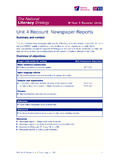Transcription of Deployment of teaching assistants in schools - GOV.UK
1 Deployment of teaching assistants in schools Research Report June 2019 Amy Skipp and Vicky Hopwood ASK Research 2 Contents Acknowledgements 4 Executive Summary 5 Key findings 5 Models of TA Deployment 5 Additional tasks being carried out by TAs 7 TA Employment 7 Benefits and challenges of TA Deployment 7 Changes in TA numbers and Deployment 8 Factors affecting decision-making 8 Conclusions 8 Section 1: Background and Methodology 9 Aims 9 Sample 10 Achieved sample 10 Methodology 11 Section 2: How are schools allocating and deploying TAs? 13 Numbers of TAs 13 Issues affecting the reliability of figures reported 15 Models of Deployment 15 Whole-class support 16 Targeted in-class support 18 Out-of-class targeted interventions 21 Factors affecting TA allocation 24 Planning 24 TA job titles and levels 25 Higher Level teaching assistants 25 Unqualified teacher status 26 Apprentice TAs 26 Other support staff 26 Wide-ranging additional tasks 27 Section 3: Recruitment, contracts, management and training of TAs 28 3 Contracts 28 Recruitment and Skills 29 Management 30 Line Management 30 Performance Management 30 Training 31 Section 4.
2 Changes in TA numbers and factors affecting decision-making around TA Deployment and 32 Changes in TA numbers 32 Decision-making on TA Deployment 33 Evidence and expertise 33 Pupil cohorts 34 Funding 35 Balancing available resource and pupil needs 37 Section 5: Benefits and challenges of TA Deployment 40 Benefits 40 Challenges 41 school -based 41 Sector-wide 42 Section 6: Conclusions 44 References 47 Annexe 48 4 Acknowledgements We would like to thank staff at the schools that participated in this research for their time and invaluable contribution. Also we are grateful for the support of the team at the Department for Education.
3 We were supported in this work by Rob Webster and Dr Amelia Roberts both from the UCL Centre for Inclusive Education. We are incredibly grateful for their involvement and insightful input. 5 Executive Summary teaching assistants (TAs) account for around a quarter (28%) of the overall state-funded school workforce (DfE, 2018). In recent years, research has begun to examine how TAs can be deployed effectively (Sharples et al., 2015). This research has shown that TAs who are sufficiently trained and used correctly within the classroom for example, as a supplement to teachers and not a replacement can have a positive impact on pupil engagement and attainment.
4 Wider evidence also suggests that TAs can have a positive impact on academic achievement, however, effects vary (Blatchford et al., 2009). Despite this work, there is little up-to-date evidence of how schools actually do deploy and allocate TAs, what TAs are doing inside and outside of the classroom and what is informing schools decision-making on how and where TAs are deployed. This exploratory qualitative research was commissioned by the Department for Education (DfE) in order to understand more about TA Deployment in schools . Specifically, the research sought to: explore models of Deployment in a range of primary and secondary mainstream schools in England; understand the factors affecting TA Deployment ; and identify any reasons for changes in TA Deployment (both historical and those planned for the future).
5 The findings are based on 60 semi-structured qualitative telephone interviews with headteachers or nominated members of staff ( deputy/ assistant headteachers, senior leadership team members, or special educational needs co-ordinators (SENCO)) in 30 primary and 30 secondary schools in England. Interviews took place in October and November 2018. Participating schools reflected a range of characteristics including: maintained and academy school status; region (including London and non-London schools ); Ofsted rating; number of pupils; proportions of pupils eligible for free school meals (FSM) and proportions recorded as having special educational needs and disability (SEND).
6 Key findings A total headcount of 922 TAs were reported to be employed across the 60 schools participating in this research. Half of the schools employed a Higher Level teaching assistant (HLTAs), with 80 HLTAs in total being employed across these 30 schools . A third of participating schools (nineteen) reported that they currently had vacant TA posts, while twelve schools reported they were using temporary staff from an agency or bank system. Models of TA Deployment There were three main ways in which TAs were described by school respondents as being primarily deployed: 6 1. Whole-class TAs Deployment of TAs as a general support to the whole class was the common mode of Deployment stated by primary schools .
7 No secondary schools reported allocation of TAs in this way. Primary school respondents explained that whole class TAs were used to provide an extra adult within the classroom to support the teacher to meet the wide range of needs and abilities in a group of young children. They were reported as supporting learning, breaking work down and personalising it to pupils needs. Often the TA rotated around different groups of pupils, as did the teacher. This meant pupils of all abilities got some time with a teacher and some time with a TA. 2. In-class targeted TAs Allocating TAs for targeted in-class support was the most commonly reported mode of Deployment by secondary schools and the second most common method of TA Deployment by primary schools .
8 In-class targeted TAs were primarily being deployed as a specific resource to support pupils with special educational needs (SEND). This included both those with Education, Health and Care (EHC) plans and those on special educational needs (SEN) support. In-class targeted TAs were also reported as being deployed to provide support for pupils with English as an Additional Language (EAL), Looked After Children (LAC) or those with other identified barriers to learning. In-class targeted TAs were carrying out similar tasks to whole-class TAs in the way they provided support in the classroom. But, in addition, they were being deployed for further support, such as differentiating or deliver lesson content, managing pupil behaviour and anxiety issues, and to implementing coping strategies for specific pupils.
9 TAs were deployed as a means to provide additional input stipulated in pupils EHC plans. 3. Withdrawal intervention delivery Primary and secondary schools also reported deploying TAs to withdraw pupils for intervention delivery. Interventions took place either in addition to class taught lessons (such as lunchtime or tutor time) or instead of class taught lessons (such as withdrawing pupils from Modern Foreign Language lessons or alternating withdrawal from different subjects or lessons). TAs deployed for intervention delivery were allocated to pupils with identified needs. This was predominantly pupils with EHC plans, those on SEN Support, with EAL, LAC, those attracting pupil premium, and those with Social Emotional and Mental Health (SEMH) issues.
10 T he main interventions detailed were bespoke activities (to prepare for or reinforce work done in class) and bought in evidence-based interventions (for numeracy or literacy). Interventions were also used as a means to address specific areas of need (such as for speech and language or occupational therapy, SEMH pupils) and to support independence and inclusion. Although primary and secondary schools gave an indication of the main mode of TA Deployment , in reality most schools stated that they were using their TA workforce flexibly across these different roles. 7 Additional tasks being carried out by TAs As well as being deployed to support teaching and learning in the ways detailed above, TAs were also reported by interviewees as routinely carrying out other tasks.













